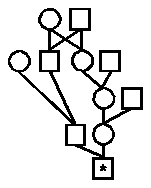Use lecture handouts when necessary. Ring tutor or J. Mallet when all else fails!
1) In a study of evening primroses, Levy and Levin (1975) used electrophoresis to study the gene for phosphoglucose isomerase-2 in different strains. They found the following genotypes:
a) Estimate the allele frequencies at this locus, and then, using the Hardy-Weinberg law, find the expected genotypic frequencies.A1A1 A1A2 A2A2 Total35 19 3 57
b) Use these
frequencies
to estimate the expected numbers of genotypes, and test for deviation
from
Hardy-Weinberg using a chi-square goodness of fit test [Note: ![]() , where O=observed numbers, E=expected numbers]; what is the total
chi-square
value?
, where O=observed numbers, E=expected numbers]; what is the total
chi-square
value?
c) Look up the probability of getting results this extreme in the following simplified chi-square table (Note: for a worked example and problems with degrees of freedom, see the lecture on "Evolution of Genetic Diversity"). Write down this P-value.
______________________________________________________________d) Is there significant evidence for deviation from Hardy-Weinberg? Write down three possible causes for a deviation (whether there is or isn't).Degrees of Value of Pfreedom 0.99 0.9 0.5 0.1 0.05 0.01 0.0011 0.00 0.02 0.46 2.71 3.84 6.63 10.832 0.02 0.21 1.39 4.61 5.99 9.21 13.82
2) Phenylketonuria is an autosomal recessive form of severe mental retardation. About 1 in 10,000 newborns are affected.
a)
Assuming
random mating, what is the expected frequency of heterozygous carriers
assuming equilibrium between mutation and selection has been reached?
If
phenylketonuria
is at the equilibrium of mutation/selection balance, we expect the
equilibrium
frequency q* to be ![]() (
(![]() is the
mutation rate,
s is the selection coefficient; see notes on mutation/selection
balance, or follow the link on this subject from "Evolution
of Genetic Diversity" lecture, for an explanation).
is the
mutation rate,
s is the selection coefficient; see notes on mutation/selection
balance, or follow the link on this subject from "Evolution
of Genetic Diversity" lecture, for an explanation).
b)
Assuming
a typical mutation rate of ![]() ,
what is the selection pressure, s, against suffererers?
What
is the fitness? Does this value seem sensible?
,
what is the selection pressure, s, against suffererers?
What
is the fitness? Does this value seem sensible?
3) Inbreeding causes a deficit of heterozygotes in the population. Supposing the deviation from Hardy-Weinberg in question 1 is caused by inbreeding. What is the value for F? HINT:Observed heterozygote frequency = 2pq (1-F). Rearrange to solve for F.
4) It has been suggested that we should not allow people who have deleterious phenotypes to reproduce. Suppose a gene causing a recessive disease has a frequency of 0.05 in the population.
a) Assuming random mating, what is the fraction showing the disease?
b) Using the formula given in the "selection and the single gene" lecture, what will be the change in gene frequency in a single generation (Dp) if we prevent such people reproducing? (This is equivalent under natural selection to killing off the recessive phenotypes, so that s=1. (HINT:the change in frequency of the recessive allele has the same magnitude but is opposite in sign to the change in the dominant allele frequency, if you think about it!).
c) What is the new gene frequency after one generation? What will be the new genotype frequency assuming Hardy Weinberg?
d) Is the approximation given in the lecture notes good for so large a frequencyas p=0.05? (See the lecture notes, "Selection and the single gene", under "How fast do populations respond?")
e) Explain whether you think it is a good idea to prevent people with recessive genetic diseases from having children.
 5)
My Dad is my Mum's first-cousin-once-removed (see diagram on left; I am
marked with a *).
5)
My Dad is my Mum's first-cousin-once-removed (see diagram on left; I am
marked with a *).
a) What is my inbreeding coefficient, F? (i.e. the probability that I have a diploid allele at any locus that is identical by descent through my grandparents. Ignore sex-linkage).
b) Is it a bad thing to
be
so inbred?